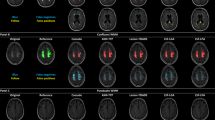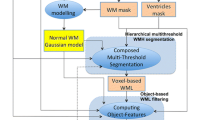Abstract
White matter hyperintensities (WMH) are a hallmark of small vessel diseases (SVD). Yet, no automated segmentation method is readily and widely used, especially in patients with extensive WMH where lesions are close to the cerebral cortex. BIANCA (Brain Intensity AbNormality Classification Algorithm) is a new fully automated, supervised method for WMH segmentation. In this study, we optimized and compared BIANCA against a reference method with manual editing in a cohort of patients with extensive WMH. This was achieved in two datasets: a clinical protocol with 90 patients having 2-dimensional FLAIR and an advanced protocol with 66 patients having 3-dimensional FLAIR. We first determined simultaneously which input modalities (FLAIR alone or FLAIR + T1) and which training sets were better compared to the reference. Three strategies for the selection of the threshold that is applied to the probabilistic output of BIANCA were then evaluated: chosen at the group level, based on Fazekas score or determined individually. Accuracy of the segmentation was assessed through measures of spatial agreement and volumetric correspondence with respect to reference segmentation. Based on all our tests, we identified multimodal inputs (FLAIR + T1), mixed WMH load training set and individual threshold selection as the best conditions to automatically segment WMH in our cohort. A median Dice similarity index of 0.80 (0.80) and an intraclass correlation coefficient of 0.97 (0.98) were obtained for the clinical (advanced) protocol. However, Bland-Altman plots identified a difference with the reference method that was linearly related to the total burden of WMH. Our results suggest that BIANCA is a reliable and fast segmentation method to extract masks of WMH in patients with extensive lesions.







Similar content being viewed by others
References
Auer, D. P., Pütz, B., Gössl, C., Elbel, G.-K., Gasser, T., & Dichgans, M. (2001). Differential lesion patterns in CADASIL and sporadic subcortical arteriosclerotic encephalopathy: MR imaging study with statistical parametric group comparison 1. Radiology, 218(2), 443–451.
Bland, J. M., & Altman, D. G. (1986). Statistical methods for assessing agreement between two methods of clinical measurement. Lancet (London, England), 1(8476), 307–310.
Caligiuri, M. E., Perrotta, P., Augimeri, A., Rocca, F., Quattrone, A., & Cherubini, A. (2015). Automatic detection of white matter Hyperintensities in healthy aging and pathology using magnetic resonance imaging: A review. Neuroinformatics, 13(3), 261–276. https://doi.org/10.1007/s12021-015-9260-y.
Chabriat, H., Joutel, A., Dichgans, M., Tournier-Lasserve, E., & Bousser, M.-G. (2009). Cadasil. The Lancet Neurology, 8(7), 643–653.
Chabriat, H., Hervé, D., Duering, M., Godin, O., Jouvent, E., Opherk, C., Alili, N., Reyes, S., Jabouley, A., Zieren, N., Guichard, J. P., Pachai, C., Vicaut, E., & Dichgans, M. (2016). Predictors of clinical worsening in cerebral autosomal dominant Arteriopathy with subcortical infarcts and leukoencephalopathy prospective cohort study. Stroke, 47(1), 4–11.
Damangir, S., Manzouri, A., Oppedal, K., Carlsson, S., Firbank, M. J., Sonnesyn, H., Tysnes, O. B., O'Brien, J. T., Beyer, M. K., Westman, E., Aarsland, D., Wahlund, L. O., & Spulber, G. (2012). Multispectral MRI segmentation of age related white matter changes using a cascade of support vector machines. Journal of the Neurological Sciences, 322(1–2), 211–216. https://doi.org/10.1016/j.jns.2012.07.064.
Damangir, S., Westman, E., Simmons, A., Vrenken, H., Wahlund, L.-O., & Spulber, G. (2017). Reproducible segmentation of white matter hyperintensities using a new statistical definition. Magma, 30(3), 227–237. https://doi.org/10.1007/s10334-016-0599-3.
De Guio, F., Reyes, S., Duering, M., Pirpamer, L., Chabriat, H., & Jouvent, E. (2014). Decreased T1 contrast between gray matter and normal-appearing white matter in CADASIL. American Journal of Neuroradiology, 35(1), 72–76. https://doi.org/10.3174/ajnr.A3639.
De Guio, F., Jouvent, E., Biessels, G. J., Black, S. E., Brayne, C., Chen, C., et al. (2016). Reproducibility and variability of quantitative magnetic resonance imaging markers in cerebral small vessel disease. Journal of Cerebral Blood Flow and Metabolism: Official Journal of the International Society of Cerebral Blood Flow and Metabolism, 36(8), 1319–1337. https://doi.org/10.1177/0271678X16647396.
De Guio, F., Vignaud, A., Chabriat, H., & Jouvent, E. (2017). Different types of white matter hyperintensities in CADASIL: Insights from 7-tesla MRI. Journal of Cerebral Blood Flow and Metabolism, 0271678X1769016. https://doi.org/10.1177/0271678X17690164.
Fazekas, F., Chawluk, J. B., Alavi, A., Hurtig, H. I., & Zimmerman, R. A. (1987). MR signal abnormalities at 1.5 T in Alzheimer’s dementia and normal aging. American Journal of Roentgenology, 149(2), 351–356.
Griffanti, L., Zamboni, G., Khan, A., Li, L., Bonifacio, G., Sundaresan, V., Schulz, U. G., Kuker, W., Battaglini, M., Rothwell, P. M., & Jenkinson, M. (2016). BIANCA (brain intensity AbNormality classification algorithm): A new tool for automated segmentation of white matter hyperintensities. NeuroImage, 141, 191–205. https://doi.org/10.1016/j.neuroimage.2016.07.018.
Grimaud, J., Lai, M., Thorpe, J., Adeleine, P., Wang, L., Barker, G. J., Plummer, D. L., Tofts, P. S., McDonald, W. I., & Miller, D. H. (1996). Quantification of MRI lesion load in multiple sclerosis: A comparison of three computer-assisted techniques. Magnetic Resonance Imaging, 14(5), 495–505.
Jenkinson, M., & Smith, S. (2001). A global optimisation method for robust affine registration of brain images. Medical Image Analysis, 5(2), 143–156.
Mangin, J.-F. (Ed.). (2000). IEEE workshop on mathematical methods in biomedical image analysis: Proceedings, Hilton Head Island, South Carolina, June 11–12, 2000. Los Alamitos, Calif: IEEE Computer Society.
Olsson, E., Klasson, N., Berge, J., Eckerström, C., Edman, Å., Malmgren, H., & Wallin, A. (2013). White matter lesion assessment in patients with cognitive impairment and healthy controls: Reliability comparisons between visual rating, a manual, and an automatic Volumetrical MRI method—The Gothenburg MCI study. Journal of Aging Research, 2013, 1–10. https://doi.org/10.1155/2013/198471.
Scheltens, P., Barkhof, F., Leys, D., Pruvo, J. P., Nauta, J. J., Vermersch, P., et al. (1993). A semiquantative rating scale for the assessment of signal hyperintensities on magnetic resonance imaging. Journal of the Neurological Sciences, 114(1), 7–12.
Schmidt, P., Gaser, C., Arsic, M., Buck, D., Förschler, A., Berthele, A., Hoshi, M., Ilg, R., Schmid, V. J., Zimmer, C., Hemmer, B., & Mühlau, M. (2012). An automated tool for detection of FLAIR-hyperintense white-matter lesions in multiple sclerosis. NeuroImage, 59(4), 3774–3783. https://doi.org/10.1016/j.neuroimage.2011.11.032.
Shiee, N., Bazin, P.-L., Ozturk, A., Reich, D. S., Calabresi, P. A., & Pham, D. L. (2010). A topology-preserving approach to the segmentation of brain images with multiple sclerosis lesions. NeuroImage, 49(2), 1524–1535. https://doi.org/10.1016/j.neuroimage.2009.09.005.
de Sitter, A., Steenwijk, M. D., Ruet, A., Versteeg, A., Liu, Y., van Schijndel, R. A., et al. (2017). Performance of five research-domain automated WM lesion segmentation methods in a multi-center MS study. NeuroImage, 163(Supplement C), 106–114. https://doi.org/10.1016/j.neuroimage.2017.09.011.
Smith, S. M. (2002). Fast robust automated brain extraction. Human Brain Mapping, 17(3), 143–155. https://doi.org/10.1002/hbm.10062.
Steenwijk, M. D., Pouwels, P. J. W., Daams, M., van Dalen, J. W., Caan, M. W. A., Richard, E., Barkhof, F., & Vrenken, H. (2013). Accurate white matter lesion segmentation by k nearest neighbor classification with tissue type priors (kNN-TTPs). NeuroImage: Clinical, 3, 462–469. https://doi.org/10.1016/j.nicl.2013.10.003.
Wardlaw, J. M., Smith, E. E., Biessels, G. J., Cordonnier, C., Fazekas, F., Frayne, R., Lindley, R. I., O'Brien, J. T., Barkhof, F., Benavente, O. R., Black, S. E., Brayne, C., Breteler, M., Chabriat, H., Decarli, C., de Leeuw, F. E., Doubal, F., Duering, M., Fox, N. C., Greenberg, S., Hachinski, V., Kilimann, I., Mok, V., Oostenbrugge Rv, Pantoni, L., Speck, O., Stephan, B. C., Teipel, S., Viswanathan, A., Werring, D., Chen, C., Smith, C., van Buchem, M., Norrving, B., Gorelick, P. B., Dichgans, M., & STandards for ReportIng Vascular changes on nEuroimaging (STRIVE v1). (2013). Neuroimaging standards for research into small vessel disease and its contribution to ageing and neurodegeneration. The Lancet Neurology, 12(8), 822–838.
Author information
Authors and Affiliations
Corresponding author
Ethics declarations
Conflict of Interest
The authors declare that they have no conflict of interest.
Ethical Approval
All procedures performed in studies involving human participants were in accordance with the ethical standards of the institutional and/or national research committee and with the 1964 Helsinki declaration and its later amendments or comparable ethical standards.
Informed Consent
Informed consent was obtained from all individual participants included in the study.
Rights and permissions
About this article
Cite this article
Ling, Y., Jouvent, E., Cousyn, L. et al. Validation and Optimization of BIANCA for the Segmentation of Extensive White Matter Hyperintensities. Neuroinform 16, 269–281 (2018). https://doi.org/10.1007/s12021-018-9372-2
Published:
Issue Date:
DOI: https://doi.org/10.1007/s12021-018-9372-2




